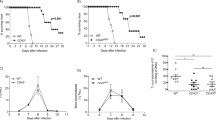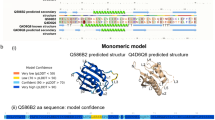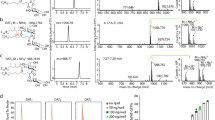Abstract
Lymphocyte polyclonal activation is a generalized mechanism of immune evasion among pathogens. In a mouse model of Trypanosoma cruzi infection (American trypanosomiasis), reduced levels of polyclonal lymphocyte responses correlate with resistance to infection and cardiopathy. We report here the characterization of a parasite protein with B-cell mitogenic properties in culture supernatants of infective forms, the cloning of the corresponding gene and the analysis of the biological properties of its product. We characterized the protein as a co-factor-independent proline racemase, and show that its expression as a cytoplasmic and/or membrane-associated protein is life-stage specific. Inhibition studies indicate that availability of the racemase active site is necessary for mitogenic activity. This is the first report to our knowledge of a eukaryotic amino acid racemase gene. Our findings have potential consequences for the development of new immune therapies and drug design against pathogens.
This is a preview of subscription content, access via your institution
Access options
Subscribe to this journal
Receive 12 print issues and online access
$209.00 per year
only $17.42 per issue
Buy this article
- Purchase on Springer Link
- Instant access to full article PDF
Prices may be subject to local taxes which are calculated during checkout






Similar content being viewed by others
References
Reina-San-Martin, B., Cosson, A. & Minoprio, P. Lymphocyte polyclonal activation: a pitfall for vaccine design against infectious agents. Parasitol. Today 16, 62–67 (2000).
Minoprio, P., Itohara, S., Heusser, C., Tonegawa, S. & Coutinho, A. Immunobiology of murine T. cruzi infection: the predominance of parasite-nonspecific responses and the activation of TcRI T cells Immunol. Rev. 112, 183– 207 (1989).
Eisen, H., Petry, K. & Voorhis, W.V. The origin of the autoimmune pathology associated with Trypanosoma cruzi infection (Academic, New York, 1990).
Ribeiro-dos-Santos, R. et al. Anti-CD4 abrogates rejection and reestablishes long-term tolerance to syngeneic newborn hearts grafted in mice chronically infected with Trypanosoma cruzi. J. Exp. Med. 175, 29–39 (1992).
Tarleton, R., Zhang, L. & Downs, M. Autoimmune rejection of neonatal heart transplants in experimental Chagas' disease is a parasite-specific response to infected host tissue. Proc. Natl. Acad. Sci. USA 94, 3932 –3937 (1997).
Arala-Chaves, M., d'Imperio-Lima, M.R., Coutinho, A., Pena-Rossi, C. & Minoprio, P. V-region-related and -unrelated immunosuppression accompanying infections. Mem. Inst. Oswaldo Cruz 87, 35–41 ( 1992).
Minoprio, P., Eisen, H., Joskowicz, M., Pereira, P. & Coutinho, A. Suppression of polyclonal antibody production in Trypanosoma cruzi infected mice by treatment with anti-L3T4 antibodies . J. Immunol. 139, 545– 550 (1987).
Minoprio, P., Coutinho, A., Spinella, S. & Hontebeyrie-Joskowicz, M. Xid immunodeficiency imparts increased parasite clearance and resistance to pathology in experimental Chagas'disease. Int. Immunol. 3, 427–433 (1991).
Santos-Lima, E.C. & Minoprio, P. Chagas' disease is attenuated in mice lacking γδ T cells Infec. Immun. 64, 215–221 ( 1996).
Cordeiro.da.Silva, A., Guevara.Espinoza, A., Taibi, A., Ouaissi, A. & Minoprio, P. A 24 kDa Trypanosoma cruzi antigen is a B cell activator. Immunology 94, 189–196 (1998).
Contreras, V.T., Salles, J.M., Thomas, N., Morel, C.M. & Goldenberg, S. In vitro differentiation of Trypanosoma cruzi under chemically defined conditions. Mol. Biochem. Parasitol. 16, 315–327 ( 1985).
Dragon, E.A., Sias, S.R., Kato, E.A. & Gabe, J.D. The genome of Trypanosoma cruzi contains a constitutively expressed, tandemly arranged multicopy gene homologous to a major heat shock protein. Mol. Cell. Biol. 7, 1271–1275 ( 1987).
Moro, A., Ruiz-Cabello, F., Fernandez-Cano, A., Stock, R.P. & Gonzalez, A. Secretion by Trypanosoma cruzi of a peptidyl-prolyl cis-trans isomerase involved in cell infection. EMBO Journal 14(11), 2483– 2490 (1995).
Cardinale, G.J. & Abeles, R.H. Purification and mechanism of action of proline racemase. Biochemistry 7, 3970–3978 (1968).
Rudnick, G. & Abeles, R. Reaction mechanism and structure of the active site of proline racemase. Biochemistry 14, 4515–4522 (1975).
Lamzin, V.S., Zbigniew, D. & Wilson, K.S. How nature deals with stereoisomers. Curr. Opin. Struct. Biol. 5, 830–836 (1995).
Barret, F.M. Changes in the concentration of free amino acids in the haemolymph of Rhodnius prolixus during the fifth instar. Comp. Biochem. Physiol. 48, 241–250 ( 1973).
Sylvester, D. & Krassner, S.M. Proline metabolism in Trypanosoma cruzi epimastigotes. Comp. Biochem. Physiol. 55 (B), 443–447 ( 1976).
de Isola, E.L., Lammel, E.M., Katzin, V.J. & Gonzalez Cappa, S.M. Influence of organ extracts of Triatoma infestans on differentiation of Trypanosoma cruzi. J. Parasitol. 67, 53–58 (1981).
Rosenberg, R.D. et al. Heparan sulfate proteoglycans of the cardiovascular system: specific structures emerge but how is synthesis regulated? J. Clin. Inv. 100, 67S–75S ( 1997).
Herrera, E.M., Ming, M., Ortega-Barria, E. & Pereira, M.E. Mediation of Trypanosoma cruzi invasion by heparan sulfate receptors on host cells and penetrin counter receptors on the trypanosomes. Mol. Biochem. Parasitol. 75(1), 73– 83 (1994).
Ortega-Barria, E. & Pereira, M.E. A novel T. cruzi heparin binding protein promotes fibroblast adhesion and penetration of engineered bacteria and trypanosomes into mammalian cells. Cell 67, 411–421 ( 1991).
Shakibaei, M. & Frevert, U. Dual interaction of the malaria circumsporozoite protein with the low density lipoprotein receptor related (LRP) and heparan sulfate proteoglycans. J. Exp. Med. 184, 1699–1711 (1996).
Thompson, R.J., Bouwer, H.G., Portnoi, D.A. & Frankel, F.R. Pathogenicity and immunogenicity of a Listeria monocytogenes strain that requires D-alanine for growth. Infect. Immun. 66(8), 3552–3561 ( 1998).
Mozes, E., Sela, M. & Taussig, M.J. Tolerance to thymus independent antigens. Characteristics of induction of tolerance to thymus independent synthetic polypeptides. Immunology 27, 641–646 ( 1974).
Sela, M. & Zisman, E. Different roles of D-amino acids in immune phenomena. FASEB J. 11, 449– 456 (1997).
Coutinho, A. & Moller, G. B cell mitogenic properties of thymus-independent antigens. Nature 245, 12– 14 (1973).
Coutinho, A., Gronowicz, E., Bullock, W.W. & Moller, G. Mechanism of thymus-independent immunocyte triggering. Mitogenic activation of B cells results in specific immune responses. J. Exp. Med. 139(1), 74–92 ( 1974).
Janeway, C.A. & Humphrey, J.H. Synthetic antigens composed exclusively of L- or D-amino acids. II. Effect of optical configuration on the metabolism and fate of synthetic polypeptide antigens in mice. Folia Biol. 16, 156–172 ( 1970).
d'Imperio-Lima, M.R., Eisen, H., Minoprio, P., Joskowicz, M. & Coutinho, A. Persistance of polyclonal B cell activation with undetectable parasitemia in late stages of experimental Chagas' disease. J. Immunol. 137, 353–356 ( 1986).
Tavares, D., Ferreira, P., Vilanova, M., Videira, A. & Arala-Chaves, M. Immunoprotection against systemic candidiasis in mice. Int. Immunol. 7(5), 785–796 (1995).
Fisher, G. in D-Amino Acids in Sequences of Secreted Peptides of Multicellular Organisms (ed. Jolles, P.) 109–118 (Birkhauser Verlag, Basel, 1998).
Wolosker, H. et al. Purification of serine racemase: biosynthesis of the neuromodulator D-serine. Proc. Natl. Acad. Sci. USA 96, 721–725 (1999).
Acknowledgements
We thank A. Waters, G. Langsley, J.C. Barale, S. Jarriault and L. de Mendonça Lima for discussions; P. Boussot and J. B. Boulé for help with automated sequencing and recombinant protein expression, respectively; L. Mulard for access to the polarimeter, A. Berneman for help with immunoblotting techniques; and E. Bischoff for helping with figure layouts. B.R.-S.-M. is a fellow of Consejo Nacional de Ciencia y Tecnologia #94587, México; W.D. is a fellow of the Pasteur/Fundação Oswaldo Cruz co-operative agreement and Institut National pour la Santé et la Techerche Médicale, France.
Author information
Authors and Affiliations
Corresponding author
Rights and permissions
About this article
Cite this article
Reina-San-Martín, B., Degrave, W., Rougeot, C. et al. A B-cell mitogen from a pathogenic trypanosome is a eukaryotic proline racemase. Nat Med 6, 890–897 (2000). https://doi.org/10.1038/78651
Received:
Accepted:
Issue Date:
DOI: https://doi.org/10.1038/78651
This article is cited by
-
Enzymatic Synthesis of D-pipecolic Acid by Engineering the Substrate Specificity of Trypanosoma cruzi Proline Racemase and Its Molecular Docking Study
Biotechnology and Bioprocess Engineering (2019)
-
d-Proline: Comment to “An overview on d-amino acids”
Amino Acids (2018)
-
Phylogenetic and syntenic data support a single horizontal transference to a Trypanosoma ancestor of a prokaryotic proline racemase implicated in parasite evasion from host defences
Parasites & Vectors (2015)
-
Pathogen manipulation of B cells: the best defence is a good offence
Nature Reviews Microbiology (2015)
-
Widespread, focal copy number variations (CNV) and whole chromosome aneuploidies in Trypanosoma cruzi strains revealed by array comparative genomic hybridization
BMC Genomics (2011)



